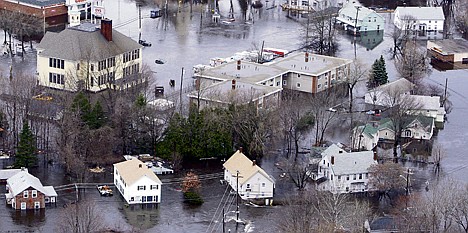Flood insurance program stops thousands
Jim Abrams | Hagadone News Network | UPDATED 15 years, 8 months AGO
WASHINGTON - Many people trying to buy a house with a riverfront view were up a creek the past few weeks because of the temporary shutdown of the federal program that provides flood insurance.
Much was made of the thousands of workers losing their unemployment checks or their access to a federal health care program while the Senate took weeks to act on an $18 billion bill to extend, through the end of May or early June, several benefits programs that had expired.
Receiving less attention were repercussions from the interruption since March 28 in the National Flood Insurance Program, an arm of FEMA.
The Senate finally acted Thursday, the House quickly sent the bill to the White House and President Barack Obama signed it that night. But the effects of the nearly three-week gap not only left a mark but hinted at what will happen if the flood program is allowed to expire again May 31.
Every business day for the past three weeks, some 1,400 potential homebuyers were unable to close on the purchase of a home because they couldn't get flood insurance, said Sen. Byron Dorgan, D-N.D. Another 12,600 people a day saw their coverage lapse because they were unable to renew their policies, Dorgan said.
The legislation did have a retroactivity clause to protect those who couldn't renew expiring policies.
Sen. Jack Reed, D-R.I., said the flood insurance hiatus complicated efforts by businesses in his flood-hit state to receive Small Business Administration loans.
There's a maximum loan threshold of $2 million to help businesses repair or replace disaster-damaged property, but without flood insurance the unsecured limit is a mere $14,000, he said.
The unavailability of flood insurance was "preventing Rhode Island homeowners and businesses from getting the full amount of disaster assistance loans. That is unacceptable and avoidable," Reed said.
The SBA said insurance companies were urged to hold new loan applications and premium payments for processing until Congress acted. Until that happened, the federal flood insurance program could neither issue new policies nor renew existing ones.
The flood insurance program was established in 1968, an outgrowth of the private insurance industry's reluctance to cover flood damage. It now provides more than $1 trillion in flood insurance to about 5.5 million homes and businesses.
Some 20,300 communities participate in the program. They have to adopt and enforce floodplain management measures. Private insurers administer the policies but the federal government collects the premiums and bears the costs for claims. The average premium is about $500 a year.
The lapse in flood insurance coverage was but one more factor, along with tight credit and the foreclosure crisis, impeding the recovery of the housing market.
"Real estate closings across the nation are delayed during this NFIP hiatus because purchasers are required to obtain flood coverage under federally backed mortgage requirements if a property is in a floodplain," said David A. Sampson, president and CEO of the Property Casualty Insurers Association of America.
The best solution to such disruptions - enacting legislation giving long-term authority to the program - has so far eluded lawmakers. The last five-year authorization expired in September 2008, and the program has hobbled along on short-term extensions since then.
Katrina and the other Gulf Coast hurricanes of 2005 largely capsized efforts to come up with new NFIP legislation. The program, which until then had been largely self-sustaining, suddenly found itself with a debt that now stands at around $18 billion and needs to be dealt with in future legislation.
A vocal group of Gulf Coast lawmakers also have pressed for adding windstorm coverage to the program. They claim that private insurers offering wind coverage avoided paying massive claims after the hurricanes by asserting that property damage, even in inland areas, was caused by federally covered floods rather than wind.
Both the Bush and Obama administrations have balked at adding wind coverage, saying it could greatly increase the NFIP's exposure to catastrophic risk.
Rep. Maxine Waters, D-Calif., who heads the House Financial Services subcommittee that oversees the issue, is set to introduce a five-year bill, with plans for a committee vote next week.
Waters' bill would not directly address the debt issue, but it would carry out some significant changes, including improving FEMA flood mapping that determines who must buy the insurance, increasing maximum coverage levels and reducing some premium subsidies for homeowners living in areas hit repeatedly by flooding.
ARTICLES BY JIM ABRAMS
House passes GOP bill to streamline job training
Is this budget a cinch?
Lawmakers tighten belts amid automatic cuts


